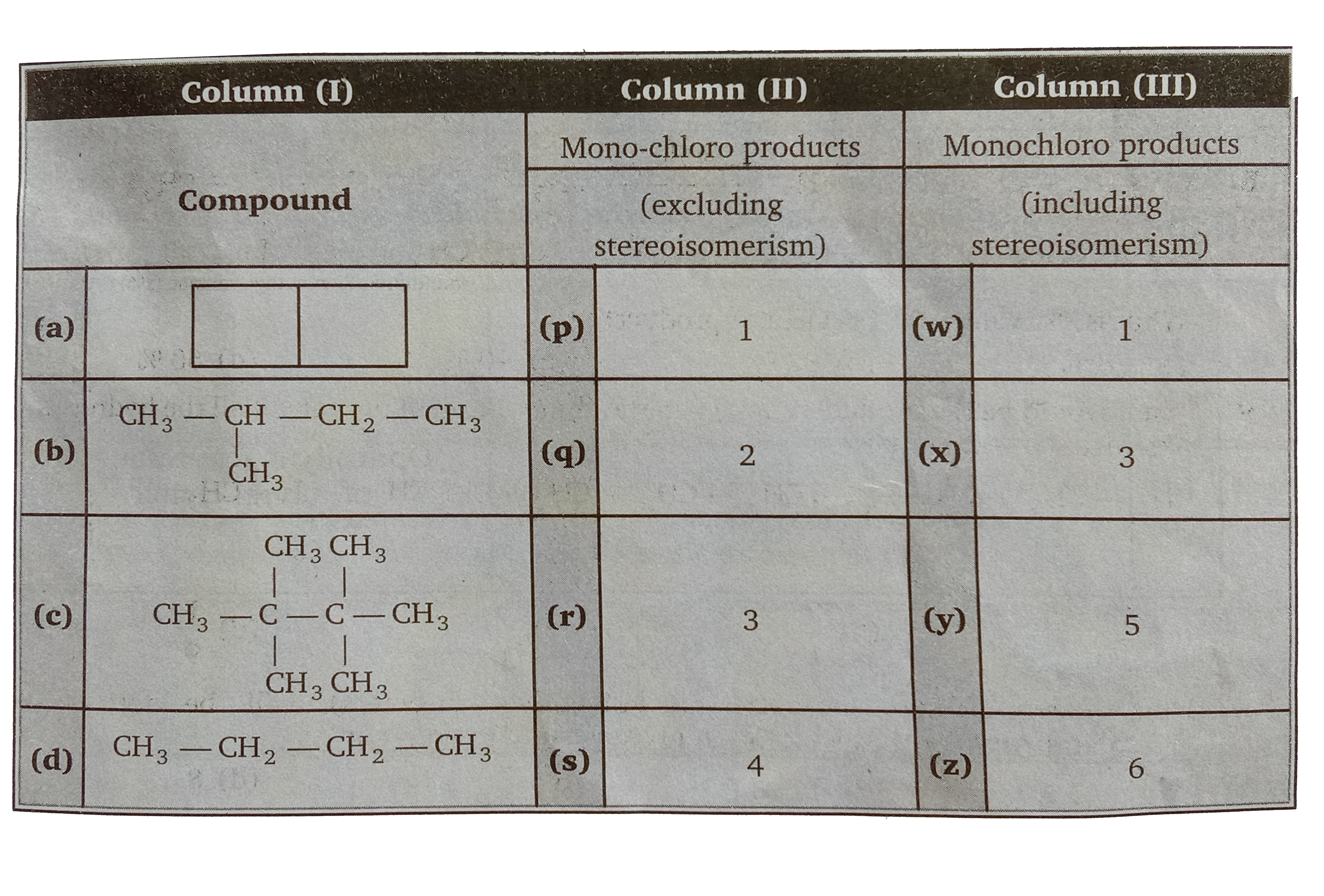Match the catalysts (Column I) with products (Column II)
Column IColumn IICatalystProduct(A)V2O5(i) Polyethylene(B)TiCl4/Al(Me)3(ii) ethanol(C)PdCl2(iii)H2SO4(D) Iron Oxide(iv)NH3
(A)−(iii),(B)−(iv),(C)−(i),(D)−(ii)
(A)−(ii),(B)−(iii),(C)−(i),(D)−(iv)
(A)−(iii),(B)−(i),(C)−(ii),(D)−(iv)
(A)−(iv),(B)−(iii),(C)−(ii),(D)−(i)
The correct Answer is:C
To solve the problem of matching the catalysts from Column I with the products from Column II, we can follow these steps:
1. Identify the Catalyst V₂O₅:
- V₂O₅ (Vanadium pentoxide) is primarily used in the Contact Process for the production of sulfuric acid (H₂SO₄).
- Match: V₂O₅ → (iii) H₂SO₄.
2. Identify the Catalyst TiCl₄/Al(Me)₃:
- TiCl₄ combined with Al(Me)₃ forms the Ziegler-Natta catalyst, which is used for the polymerization of alkenes, specifically converting ethylene (ethene) into polyethylene.
- Match: TiCl₄/Al(Me)₃ → (i) Polyethylene.
3. Identify the Catalyst PdCl₂:
- PdCl₂ (Palladium(II) chloride) is used in the Wacker Process, which converts ethanol (C₂H₅OH) into acetaldehyde (CH₃CHO).
- Match: PdCl₂ → (ii) Ethanol.
4. Identify the Catalyst Iron Oxide:
- Iron oxide (Fe₂O₃) is used as a catalyst in the Haber Process for the synthesis of ammonia (NH₃) from nitrogen (N₂) and hydrogen (H₂).
- Match: Iron Oxide → (iv) NH₃.
Final Matching:
- A (V₂O₅) → (iii) H₂SO₄
- B (TiCl₄/Al(Me)₃) → (i) Polyethylene
- C (PdCl₂) → (ii) Ethanol
- D (Iron Oxide) → (iv) NH₃
Summary of Matches:
- A → (iii)
- B → (i)
- C → (ii)
- D → (iv)
Conclusion:
The correct option that matches the catalysts with their respective products is option C:
- A3, B1, C2, D4.
- V₂O₅ (Vanadium pentoxide) is primarily used in the Contact Process for the production of sulfuric acid (H₂SO₄).
- Match: V₂O₅ → (iii) H₂SO₄.
- TiCl₄ combined with Al(Me)₃ forms the Ziegler-Natta catalyst, which is used for the polymerization of alkenes, specifically converting ethylene (ethene) into polyethylene.
- Match: TiCl₄/Al(Me)₃ → (i) Polyethylene.
- PdCl₂ (Palladium(II) chloride) is used in the Wacker Process, which converts ethanol (C₂H₅OH) into acetaldehyde (CH₃CHO).
- Match: PdCl₂ → (ii) Ethanol.
- Iron oxide (Fe₂O₃) is used as a catalyst in the Haber Process for the synthesis of ammonia (NH₃) from nitrogen (N₂) and hydrogen (H₂).
- Match: Iron Oxide → (iv) NH₃.
- A (V₂O₅) → (iii) H₂SO₄
- B (TiCl₄/Al(Me)₃) → (i) Polyethylene
- C (PdCl₂) → (ii) Ethanol
- D (Iron Oxide) → (iv) NH₃
- A → (iii)
- B → (i)
- C → (ii)
- D → (iv)
The correct option that matches the catalysts with their respective products is option C:
- A3, B1, C2, D4.
Topper's Solved these Questions
- HYDROGENBook:DISHA PUBLICATIONChapter:HYDROGENExercise:Exercise - 2 : Concept Applicator
Explore 30 Videos
- ORGANIC CHEMISTRY SOME BASIC PRINCIPLES AND TECHNIQUES Book:DISHA PUBLICATIONChapter:ORGANIC CHEMISTRY SOME BASIC PRINCIPLES AND TECHNIQUES Exercise:Exercise - 2 : Concept Applicator
Explore 30 Videos
Similar Questions
Knowledge Check
Match the cataysts (Column I) with products (Column II).
Column IColumn IICatalystProduct(A)V2O5(i)Polyethylene(B)TiCl4/Al(Me)3(ii)ethanal(C)PdCl2(iii)H2SO4(D)Iron Oxide(iv)NH3A(A)-(iii), (B)-(iv), (C )-(i), (D)-(ii)B(A)-(ii), (B)-(iii), (C )-(i), (D)-(iv)C(A)-(iv), (B)-(iii), (C )-(ii), (D)-(i)D(A)−(iv),(B)−(iii),(C)−(ii),(D)−(i)Match the catalyst given in Column I with the processes given in Column II.
 AA. →(3)B→(2)C→(5)D→(1)
AA. →(3)B→(2)C→(5)D→(1)Match the catalysts given in column I with the processesn given in column II
 Ai−c,ii−d,iii−b,iv−de,v−abBi−c,ii−d,iii−b,iv−e,v−aCi−c,ii−dc,iii−b,iv−de,v−abDi−d,ii−c,iii−b,iv−de,v−ab
Ai−c,ii−d,iii−b,iv−de,v−abBi−c,ii−d,iii−b,iv−e,v−aCi−c,ii−dc,iii−b,iv−de,v−abDi−d,ii−c,iii−b,iv−de,v−ab
Match the column I with column II and with column III.

View SolutionMatch the column I with column II and with column III.

View SolutionMatch the species in Column I with the type of hybrid orbitals in Column II.
Column IColumn II(i)BF3(a)sp3d(ii)H2O(b)sp2(iii)PCl5(c)sp3d2(iv)SF6(d)sp3
View SolutionMatch the reactions in Column I with the types of products/the use of products in Column II.

View SolutionMatch the column I with column II and mark the appropriate choice.
Column IColumn II(A)Borax(i)Na3AIF6(B)Inorganic benzene(ii)Na2B4O7.10H2O(C)Cryolite(iii)AI2O3.2H2O(D)Bauxite(iv)B3N3H6
View Solution



